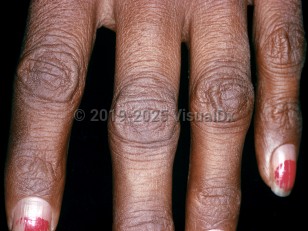Addison disease - Oral Mucosal Lesion
See also in: OverviewAlerts and Notices
Important News & Links
Synopsis

The adrenal insufficiency leads to decreased levels of glucocorticoids (the most common), mineralocorticoids, and adrenal androgens. The disease is characterized by general symptoms of fatigue, weight loss, weakness, vomiting, dizziness, cold intolerance, and muscle aches. Because these symptoms are nonspecific, the diagnosis may go unrecognized until the patient presents with a life-threatening adrenal crisis (severe hypotension and even coma).
The cutaneous manifestation of patients with chronic Addison disease is hyperpigmentation of skin and mucous membranes. Skin pigmentation, which appears as "bronzing" of the skin, is generalized and mainly affects sun-exposed areas. Oral mucosal lesions present as dark brown to black macules and frequently are the first sign of disease. These and the other clinical signs of the disease appear only after 90% of the adrenal gland is nonfunctioning. The hyperpigmentation is due to increased production of melanocyte-stimulating hormone (MSH), which is part of the adrenocorticotrophic hormone (ACTH) molecule; ACTH production in the pituitary increases in response to decreased cortisol production, leading also to an increase in MSH levels and melanosis.
Men and women are equally affected, and although all ages are affected, it is more common between the ages of 30 and 50. Estimated prevalence of the disease is at 120 per million.
Addisonian Crisis:
Acute adrenal failure presents with severe penetrating abdominal pain accompanied by vomiting and diarrhea, low blood pressure, and loss of consciousness. This is a life-threatening emergency that must be managed aggressively.
Codes
E27.1 – Primary adrenocortical insufficiency
SNOMEDCT:
363732003 – Addison disease
Look For
Subscription Required
Diagnostic Pearls
Subscription Required
Differential Diagnosis & Pitfalls

Subscription Required
Best Tests
Subscription Required
Management Pearls
Subscription Required
Therapy
Subscription Required
Drug Reaction Data
Subscription Required
References
Subscription Required

